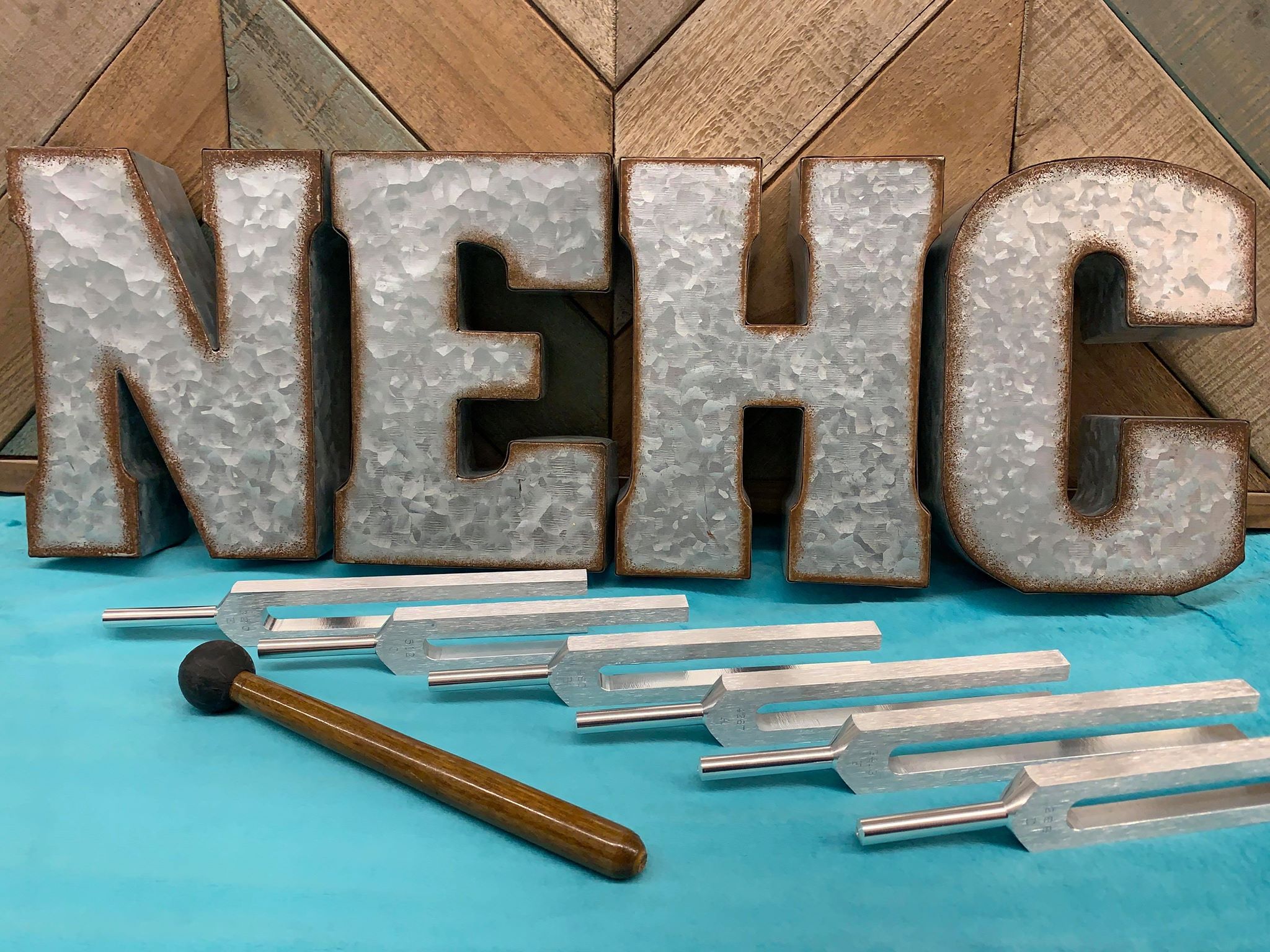In sound healing, we often hear the term “standing wave” used to describe a phenomenon of what appears to be sound energy standing still in part of a room or locations on the body. This terminology also leads many to believe that energy is “stagnant” or not moving. The purpose of this post is to show the physics of acoustics when applied to standing waves.
First, it’s important to recognize the way sound vibrations are created by an oscillating source (tuning fork tines) with molecules like air or water (the medium) being compressed and moving away from the source for the purpose of being received at some point by a receiver (our ears). In other words, sound requires a source, a medium, and a receiver to transfer mechanical vibration energy across a medium to be received and processed into usable information. Without all three parts of this equation, all we have are vibrating molecules moving throughout the medium.
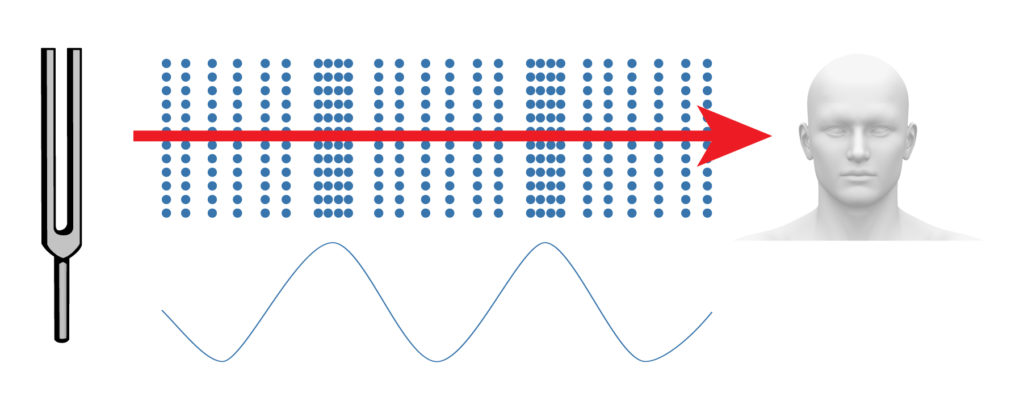
Second, without the ability for a receiver to process the vibration energy at some point along the route away from the source, the information is not being received as information. We often leave ourselves and our auditory processing system out of this equation when it comes to propagating (moving) sound energy. It is also important to keep in mind that mechanical energy is always moving away from the source that created the oscillations.
Third, the meaning of standing waves were originally considered for very specific purposes in creating sound waves for certain types of instruments like strings and brass. In these instruments, a string is plucked or a mouthpiece vibrates and the vibrations travel to the end and return along the same return route to create the standing wave phenomenon. These instruments take advantage of these waves which create louder amplitude vibrations to be transmitted into the room away from the instrument usually through holes.
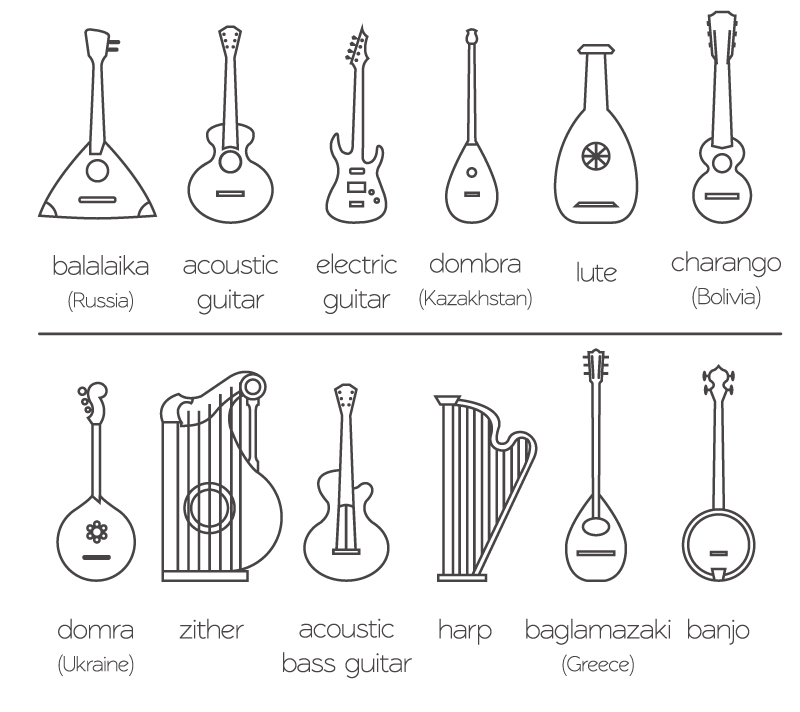
In the image below, we can see a typical X/Y plot showing the various terms of a wavefront moving away from the source on the left and moving in the direction of travel to the right. In this representation of sound energy, the peaks represent molecules being compressed while the troughs represent these same molecules spreading apart. Amplitude represents on many molecules are compressed within the medium. More compressed molecules create a higher amplitude or louder sound.
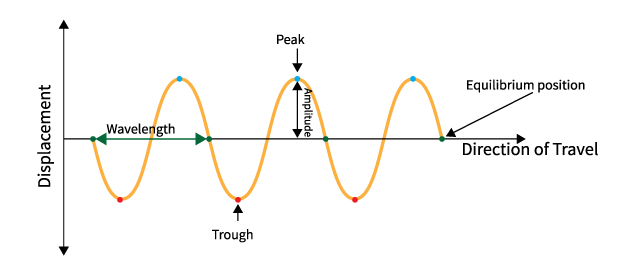
In order for a standing wave to exist, there must be a confined route the vibrations take along a string (guitar) or tube (flute) and the length of the confined route is dependent on the frequency of the vibrations. If the frequency or associated harmonics fit within the confines of the route of vibration travel, certain molecules along the route will remain in the same location (node) as the outgoing and returning molecules strike both sides of this molecule causing it to stand still in space and time. Wikipedia describes “a standing wave, also known as a stationary wave, is a wave which oscillates in time but whose peak amplitude profile does not move in space. The peak amplitude of the wave oscillations at any point in space is constant with time, and the oscillations at different points throughout the wave are in phase.” https://en.wikipedia.org/wiki/Standing_wave
We often see a standing wave described using an X/Y plot, but we rarely see it explained in reference to moving molecules to see center node molecule standing still. In the animation below, we can see the blue circle on the left moving away from the source (tuning fork tine) and the blue circle on the right returning from the wall at the other end at the same time to strike the red circle at the exact same time. The associated X/Y plot below it shows the node location where there is not amplitude or sound coming from the red circle location.
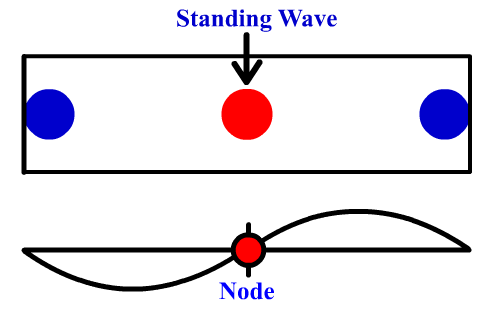
There is no moving vibrations within the location of a node, and the anti-node blue circles are still not moving outwards but rather remaining within a confined space. Remember that these repeating oscillations returning on themselves are only used within an instrument to increase the volume for another part of the instrument to broadcast the sound out into the room in a moving wave. The phenomenon of a standing wave has done its job and remains within the restricted route of the instrument string or tube. No receiver was ever part of the standing wave equation. Our ears only receive the moving waves traveling away from the instrument.
Now let’s apply this standing wave concept to sound healing where instruments are played in a room and broadcast into an open space. It is often understood that there are standing waves located throughout the room where sound energy is stagnant and people in the room can benefit from these locations of higher energy. In reality, the acoustic travel of sound sources within an open room does not create a closed path specific to a certain frequency required to create the phenomenon of a standing wave.
As vibrations travel away from a source, those waves will go through many types of events from bouncing off the walls, scattering in different directions off objects, and being absorbed by heat caused by friction.
In the image below, we can see what happens in an open space when room acoustics become a big part of the sound travel equation. Vibrations from a source will take multiple routes to reach our ears including two specific directions of travel. The red sound waves leaving the tuning fork travel in a direct route to the ear, and the blue sound wave is a reflection off a nearby wall where the angle is sufficient to reach our ear at the exact same time as the direct waves.
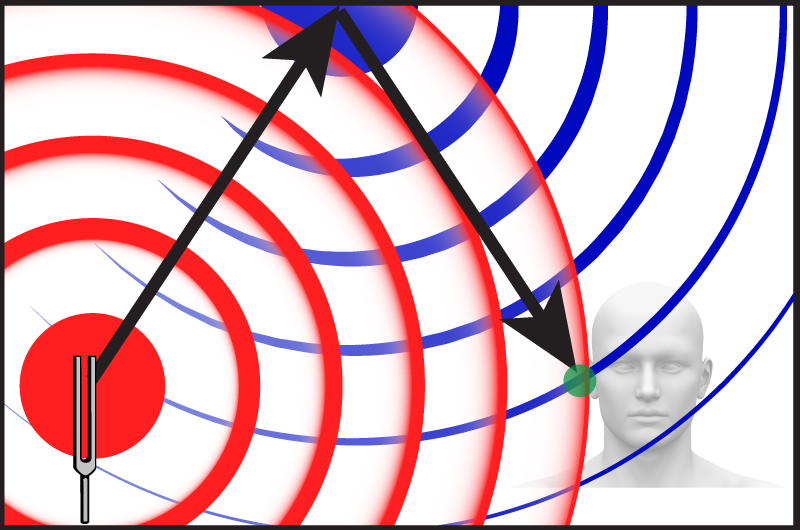
This phenomenon is known as constructive interference where to two waves of similar frequency can increase their combined amplitude to create a much louder vibration. The green circle indicates where the direct and reflected waves overlap in a very specific way to sound louder if all of the angles align perfectly. This is not a standing wave. These are moving sound energy waves propagating away from the source and providing a very temporary constructive interference overlap. There is nothing stagnant about these sound waves.
This equation becomes even more complex when two human bodies are involved in sound healing. It is important for sound healers to recognize the physics of acoustics in an open room because the sound waves reaching the practitioner’s ears are not the same dynamics and energy reaching the client. Just because a practitioner hears the tuning fork transmitting a sound with certain characteristics does not mean the client experiences the same thing. The practitioner and the client’s ears are in two locations receiving the sound waves independent of each other.
Based on the information present here, it is my opinion and belief that sound waves are always moving instead of being stagnant and storing information in one specific location. The source is always changing in frequency, strength, and location and so is the receiver(s) in this very complex acoustic environment. As sound healers, we should be focusing more on the quality and location of the sound source and the way those vibrations are reaching both the client’s auditory system and the sensors underneath the skin design to receive and process mechanical vibrations.
Supporting references:
https://www.acs.psu.edu/drussell/Demos/StandingWaves/StandingWaves.html
https://www.acs.psu.edu/drussell/Demos/superposition/superposition.html
https://en.wikipedia.org/wiki/Standing_wave
https://www.physicsclassroom.com/class/waves/Lesson-4/Formation-of-Standing-Waves
https://www.earmaster.com/music-theory-online/ch03/chapter-3-2.html

